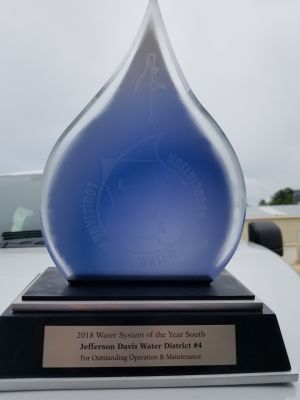The basic regulations which govern the operation of a public water system are contained in LAC 51: XII (formerly Chapter XII, Water Supplies, in the Sanitary Code of the State of Louisiana). LAC 51: XII also incorporates, by reference, all applicable provisions of the National Primary Drinking Water Regulations.
Following the above regulations the Jeff Davis Parish Police Jury created the Jeff Davis Water District #4 water system in November of 1979. The system started laying lines in June of 1986. The first billing for the sale of water was in August of 1987.
The Jeff Davis Water District #4 water system gets its supply of ground water from the Chicot Aquifer by utilizing three (3) wells, which alternate by demand of the system. There is 345,000 gallons of potable drinking water storage capacity. The coverage of the service area is approximately Twelve miles long by approximately five miles wide covering from Interstate 10 North to F.E. Landry Road and From Bayou Nezpique West to Elton Drive. The distribution system consist of approximately One hundred Fifty (150) miles of 8, 6, 4, 3, & 2 inch PVC water mains. There are eighty-five (85) flushing points throughout the water district. The entire system is flushed once a month. The system operates with a 3 pump variable drive frequency pumping system that runs on demand. Operating at lowest gpm needed, up to 1200 gpm needed to maintain 66PSI. The water is injected with Potassium Permanganate and Chlorine. The Chlorine is injected by means of a chlorinator and adjusted to maintain a 0.80 Cl2 residual at the water plant which helps us to maintain the L.D.H. required greater than 0.50 residual throughout the distribution system. It then enters the filters this is an oxidation process which allows the filters to trap iron and manganese before it enters the system. After the water exits from the filters, it then goes to the softening units, which uses a treated brine solution to create an ion exchange softening process. Which softens the water to between a 51.3 - 68.4 mg/L. Ideal water hardness for drinking water ranges between approximately 34.2 to 102.6 mg/L. Above this level, hardness can contribute to scaling of water heaters and boilers. Water with hardness below this level tends to be more aggressive and can cause deterioration of the inner surface of pipes, eventually leading to pinholes or leaks. To help protect from these pin holes and leaks our water then gets treated with ZO-190 a zinc orthophosphate which is a corrosion inhibitor. This also is a treatment to reduce the amount of lead and copper (see our page on Lead & Copper for more info) that may be picked from solder, fixtures, and piping in your homes. While the water system has very little iron and copper to protect from corrosion and lead/copper intrusion, we inject ZO-190 to help protect you the customer, and the piping and fixtures in your homes. From this point, the water goes to the ground storage tanks, then out into the distribution system and to your homes. If you need more information on your water, or wish to visit the water plant do not hesitate to call our office. The water supply is tested at the plant & the distribution system daily for Chlorine Residual, PH & Hardness. Iron, Manganese, & Ortho Phosphates are checked throughout the system weekly. If you would like to see these results or have us test your water at your home give us a call to set up a date and time.

